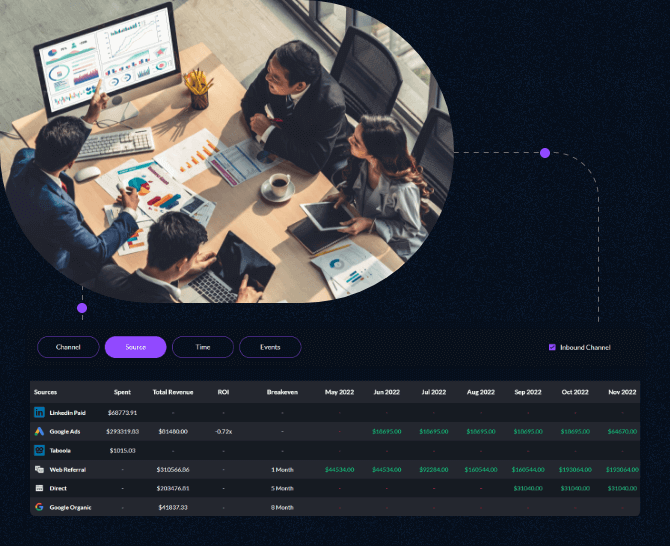
Beyond the Numbers: The Human Element in Marketing Analytics
The human element still plays a vital role in interpreting, understanding, and making meaningful decisions based on your marketing analytics data. In this blog post, we've highlighted the need for businesses to embrace the human element to drive effective and customer-centric marketing strategies and achieve success.
Mike Schmoker, a former administrator and English teacher, said, “Things get done only if the data we gather can inform and inspire those in a position to make a difference.”
This quote from a relatively unknown person sums up the dichotomy that most businesses face. On the one hand, Big Data, Artificial Intelligence, and Machine Learning have been the buzzwords in the marketing industry. At the same time, the role of the human element hasn’t been diminished and rather become more important to overcome the cacophony of quantitative data.
No business today can succeed unless it has complete command over its data and makes meaning out of it using marketing analytics. However, amidst the sea of data, it is essential not to ignore the vital role the human element plays. They interpret and understand these numbers. While Marketing data focuses on numbers, the human element gets inside the minds of the customers to strike an emotional chord with them.
Let us now turn our attention to the significance of embracing the human element in marketing analytics. We shall look into how human insights, emotional intelligence, and storytelling are the cornerstone of data-driven decision-making. They drive effective and customer-centric marketing Analytics strategies and put businesses ahead of the competition.
The Importance of the Human Element in Marketing Analytics
On the face of it, data provides valuable information, but it requires human scrutiny and interpretation to uncover meaningful insights. Human analysts can identify patterns, context, and nuances that data might overlook. Understanding consumer emotions is the biggest differentiator in marketing. Emotional intelligence allows marketers to make decisions that resonate with their target audience, creating stronger connections and brand loyalty.
For instance, let’s consider the case of an eCommerce company that runs marketing campaigns to attract new customers and increase sales. They collect data using website traffic, click-through rates, conversion rates, and purchase patterns over several months. Now, you’d need a human analyst to gather insight into which marketing campaigns result in higher engagement, what triggers the customers to purchase, and what time of the day, week, or month the likelihood of sales increases.
While quantitative data is powerful, it has its limitations. A sole focus on numbers might miss qualitative aspects and fail to grasp the complete customer experience. No business can succeed by putting marketing analytics into autopilot. Marketing analytics tools are like brushes in the hands of a painter. It ultimately boils down to the painter’s skills to create a masterpiece or a disaster!
The Power of Storytelling
It is famously said, “Storytelling is the most powerful way to put ideas into the world.” It bridges the gap between raw data and meaningful insights. As a marketer, you can use narratives to make data more relatable and actionable for all stakeholders in the C-Suites. Data-driven stories capture attention, spark interest, and, more importantly, drive user engagement. It effectively lets your business articulate your successes and set the tone for future directions.
Human analysts bring the expertise to convert complex data findings into practical recommendations. Your role is to supercharge the marketing campaigns and overall business strategy based on the data you generate using marketing analytics tools.
Why Is the Human Element Irreplaceable?
Technology replacing humans has been the biggest lie ever told in marketing. If anything, information technology at large and marketing analytics, in particular, is resource-driven. While technology helps reduce the burden of mundane tasks on humans, without human elements interpreting the data and making decisions, technology can go nowhere. The art of translating data into actionable recommendations requires a well-pronged approach. Let us look at the role of the human element in this matrix.
Empathy and Understanding the Customer
Incorporating a customer-centric approach in data analysis is vital for earning customers’ loyalty. Empathy plays a crucial role here. It helps you put yourself in your customers’ shoes. You get to know about their needs, fears, and aspirations. When you understand your customer’s pain points, you can solve them.
You need to use qualitative data to uncover customer needs and motivations. As your years of experience in marketing would tell you, quantitative data provides the “what,” but qualitative data unveils the “why” behind customer behavior. Qualitative data combined with empathy-driven marketing strategies can create a strong bond with your customers, building trust and fostering long-term relationships.
Collaboration and Communication
Humans have a key role in breaking down silos and fostering cross-functional collaboration. Effective marketing analytics requires deep collaboration between data analysts, marketing, and executive teams. You have to present data clearly and comprehensively that is palatable for non-technical decision-makers in your organization. You must foster an environment for seamless integration between analytics and marketing teams. Decision-making may not be well-aligned with overall marketing objectives without the human element.
Ethical Considerations
Modern consumers are more aware compared to their predecessors. As a marketer, you must navigate the ethical considerations of using data responsibly and ensure that all your decisions prioritize consumer well-being. Here, we must also emphasize on the importance of protecting consumer privacy and data security. With the latest privacy laws, such as the General Data Protection Regulation and California Consumer Privacy Act, data collection and analysis must adhere to these regulations and secure practices to safeguard customer trust. Can you imagine AI and Machine Learning tools to make these ethical considerations? Not as of today, surely!
Fostering Creative Solutions
The human element brings creativity and innovation to problem-solving. Beyond mere data analysis, your team can creatively frame narratives and develop innovative campaign concepts based on their resonance with the audience. When your team puts its creative hat on, you can solve unforeseen challenges where data alone may not be enough. By infusing marketing strategies with the human touch, you can connect with consumers deeper, delivering more impactful and successful campaigns.
Human-Centered Analytics Culture
Customers aren’t milking cows but important stakeholders in your business. Hence, your analytics culture must have a human touch. As you focus on a human-centered analytics culture, you must build a team with analytical acumen and strong interpersonal skills. You must nurture a culture that values data and human insights, as striking the right balance between the two is essential for creating a culture with equal eyes on creativity, empathy, and collaboration. Building an analytics team is a continuous exercise, and here organizations must encourage continuous learning and ensure that the team stays updated on the latest trends, technologies, and soft skills.
Bottom Line
Incorporating the human element into marketing analytics is a must for success. Technology has come a long way in the last decade but has yet to exceed the power of human insights and storytelling. When you focus on empathy and ethical considerations, you can create a truly customer-centric and effective marketing strategy that goes beyond the numbers. Embracing the human element will help supercharge your marketing efforts in an increasingly data-driven world.
Want to Bring Just the Right Human Touch Into Your Marketing Analytics? Let’s Talk!
Our marketing analytics aces would love to pitch in. Just write to us at info@diggrowth.com and we’ll take it from there.
Ready to get started?
Increase your marketing ROI by 30% with custom dashboards & reports that present a clear picture of marketing effectiveness
Start Free Trial
Experience Premium Marketing Analytics At Budget-Friendly Pricing.

Learn how you can accurately measure return on marketing investment.
Additional Resources
Don’t Let AI Break Your Brand: What Every CMO Should Know
AI isn’t just another marketing tool. It’s changing...
Read full post postFrom Demos to Deployment: Why MCP Is the Foundation of Agentic AI
A quiet revolution is unfolding in AI. And...
Read full post postAnswer Engine Optimization (AEO): The New Frontier of SEO in 2026
As digital experiences continue to evolve, so does...
Read full post post

